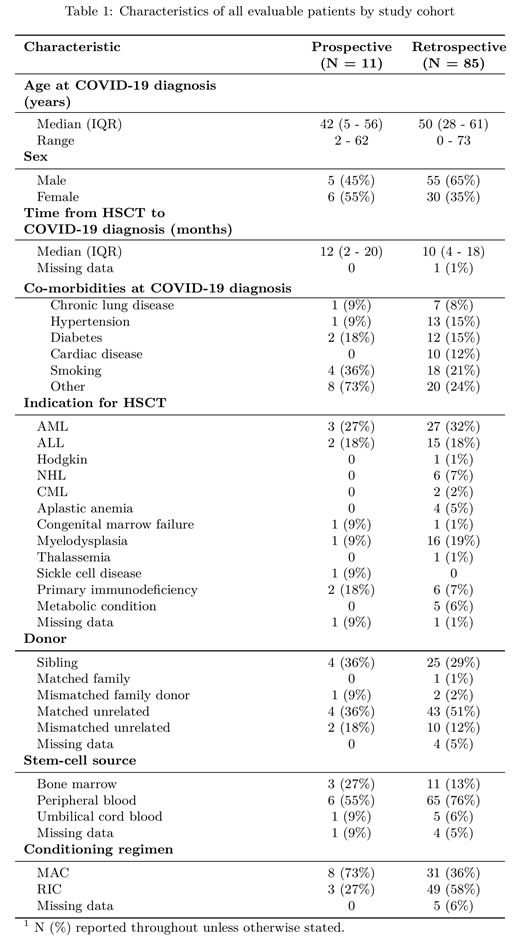Abstract
Introduction
The clinical manifestations of COVID-19 infection in recipients of allogeneic hematopoietic stem cell transplantation (HSCT) have been reported in multiple retrospective cohorts of patients, but there have been no prospective studies to date. Previous studies report that HSCT recipients are at higher risk, with cumulative incidence of death between 17-35%. Although an excessive pro-inflammatory viral response has been documented in the general population, its role in the immune incompetent HSCT setting has not been documented.
We present a combined prospective and retrospective national study run through the UK IMPACT trial network to characterize the clinical and immunological features of COVID-19 infection in 96 adult and pediatric recipients of HSCT in the United Kingdom.
Methods
HSCT recipients of any age and transplanted for any indication, with an RT-PCR-proven COVID-19 infection, were eligible for this study. Patients within 72 hours of COVID-19 diagnosis, who had not received cytokine-targeted treatment, were recruited to a prospective cohort. All other patients were eligible for a retrospective cohort. Prospective patients provided blood samples within 72 hours of COVID-19 diagnosis, and again within 72 hours of clinical deterioration (defined as requirement for oxygen administration) if applicable. Follow-up data were collected on patients 30 and 100 days after COVID-19 diagnosis.
Results
100 patients were recruited from 16 sites across the UK between May 2020-June 2021, comprising 12 in a prospective cohort and 88 recruited retrospectively. 96 patients were evaluable, as 4 proved ineligible post-registration. Patients were diagnosed with COVID-19 at a median of 11 months after HSCT. Patient/HSCT characteristics are shown Table 1.
The most common symptoms associated with the onset of COVID-19 were fever in 8 prospective (73%) and 35 (41%) retrospective patients, followed by cough in 5 (45%) prospective and 35 (41%) retrospective patients and dyspnea in 4 (36%) prospective and 16 (19%) retrospective patients. 8 (73%) prospective and 40 (47%) retrospective patients were actively immunosuppressed at the time of COVID-19 infection. 16% of the patients had moderate/severe disease at baseline.
At day 30 (±2 days) after COVID-19 diagnosis, 2 prospective and 8 retrospective patients continued to demonstrate SARS-CoV-2 positivity on respiratory PCR testing. The median time to viral clearance was 40 (IQR 17-78) days for the prospective and 34 (IQR 15-70) days for the retrospective cohort.
Prolonged (more than 14 days) neutropenia was reported in 4 (5%) patients in the retrospective cohort, prolonged thrombocytopenia in 2 (18%) prospective and 11 (13%) retrospective patients. 1 retrospective patient developed secondary hemophagocytic lymphohistiocytosis, and graft rejection was reported in 1 (1%) retrospective patient, within 30 days of COVID-19 diagnosis.
In the prospective cohort, 3 (27%) patients died, all by day 30, and all due to COVID-19. In the retrospective cohort, 13 (17%) patients died by day 30, rising to 18 (21%) by day 100, 61% of deaths were attributed to COVID-19.
Lower baseline platelets (p=0.013, Mann-Whitney U test), lymphocytes (p=0.012), albumin (p=0.028), and higher baseline CRP (p=0.007), were seen in patients who died following COVID-19 diagnosis. Additionally, exploratory univariate logistic regression of the retrospective cohort found mortality at day 100 to be associated with increased age at diagnosis (OR 1.04, 95% CI 1.01-1.08, p=0.04), and no requirement compared with requirement for invasive ventilation (OR 0.02, 95% CI 0.00-0.16, p=0.001).
The 11 prospective patients showed normal levels of interleukin (IL)-2, -4, -10, interferon gamma and tumor necrosis factor alpha at COVID-19 presentation. IL-6 was minimally raised (up to 127 pg/ml, nv<50) in 3/11 pts at presentation. Respiratory deterioration was not associated with detectable cytokine storm.
Conclusion
Our study confirms a significant mortality rate in patients affected by COVID-19 post HSCT and confirms age as well as requirement for invasive ventilation to be independent risk factors associated with death at day 100.
Baseline laboratory data at disease presentation can identify patients at higher risk of COVID-19 related death.
In the prospective cohort of our study, pathophysiology of the viral disease did not seem related to cytokine storm-mediated inflammation.
Protheroe: Jazz Pharmaceuticals: Honoraria; Astellas: Honoraria; Kite Gilead: Honoraria. Peggs: Autolus: Consultancy, Current equity holder in publicly-traded company. Craddock: Novartis Pharmaceuticals: Other: Advisory Board ; Celgene/BMS: Membership on an entity's Board of Directors or advisory committees, Research Funding. Nicholson: BMS/Celgene: Consultancy; Kite, a Gilead Company: Other: Conference fees, Speakers Bureau; Novartis: Consultancy, Other: Conference fees; Pfizer: Consultancy. Amrolia: ADC Therapeutics: Other: Named inventor on a patent which is being transferred to ADCT.; Autolus: Patents & Royalties.


This feature is available to Subscribers Only
Sign In or Create an Account Close Modal